NONESUCH
NEWS |
| Jevan
Berrangé , died November 2018 |
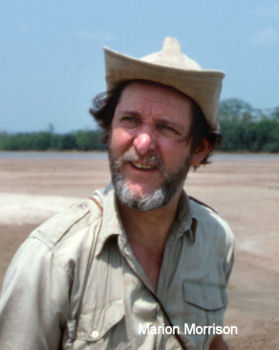 Tony
Morrison recalls ' My first meeting with Jevan, an explorer-scientist extraordinaire,
was in Manaus the old city in the centre of Amazonia. We were about to set out
in a small hovercraft on a journey to link the Amazon to the Atlantic along an
unfinished road. Amazonia was just being opened up to road-builders and the forest
people were fighting back. I was filming The Forbidden Route for
a BBC team and Jevan who was an expert in aerial mapping was our navigator. Tony
Morrison recalls ' My first meeting with Jevan, an explorer-scientist extraordinaire,
was in Manaus the old city in the centre of Amazonia. We were about to set out
in a small hovercraft on a journey to link the Amazon to the Atlantic along an
unfinished road. Amazonia was just being opened up to road-builders and the forest
people were fighting back. I was filming The Forbidden Route for
a BBC team and Jevan who was an expert in aerial mapping was our navigator.
We
had a few 'hairy' moments and one I can recall vividly was a night excursion with
Jevan in a small rubber dinghy along a remote tributary as we searched for a hovercraft
fuel dump.
Jevan
was the master of dodgy travel. The BBC Travel and Exploration Unit had drawn
Jevan into the project because he had spent years exploring and mapping southern
Guyana and its Essequibo river drainage for the British Geological Survey. 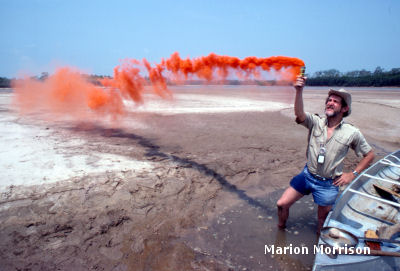 Jevan
was a meticulous worker and with a small band of local helpers he had spent months
working from aluminium canoes while living rough in the forest. His study is a
classic of field research [see my footnote]. Jevan
was a meticulous worker and with a small band of local helpers he had spent months
working from aluminium canoes while living rough in the forest. His study is a
classic of field research [see my footnote].
Over
the years we kept in touch and our next meeting 'in the field' was in Eastern
Bolivia where he was leading a BGS team of around a dozen geologists in the exploration
of the Precambrian Shield extending to the hills of western Brasil.
The Proyecto Precambrico was a British Government technical cooperation
initiative with the Bolivian Government. Here
Jevan is on the River Piraí an Amazon tributary near Santa Cruz for a photo
shoot with Marion Morrison who was writing about British Technical assistance
projects 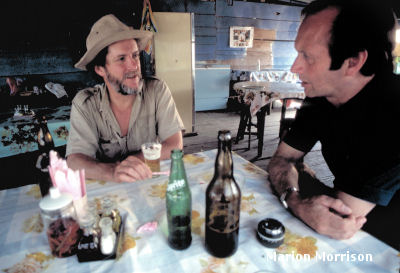 But
my interests were more historical than geological as I was on the trail of the
enigmatic British Colonel Fawcett who disappeared in the Brazilian forest in 1925.
Fawcett had spent months mapping in Precambrian Bolivia in 1908-9. From Jevan's
POV it was simply a good story -I can hear his disbelieving chuckle. But
my interests were more historical than geological as I was on the trail of the
enigmatic British Colonel Fawcett who disappeared in the Brazilian forest in 1925.
Fawcett had spent months mapping in Precambrian Bolivia in 1908-9. From Jevan's
POV it was simply a good story -I can hear his disbelieving chuckle.
Jevan recalled our earlier BBC adventures and he helped with aerial photos of
Fawcett's 'mysterious Ricardo Franco Hills' giving me the position of a huge waterfall...the
Arco Iris located by his team. We kept in touch well into his retirement'
Here we are meeting
in a small riverside bar in Bellavista just north of Santa Cruz, Bolivia - 1981
Jevan
was born in the Union of South Africa in 1931 and his father Vernon Berrangé
later became a noted human rights lawyer who in 1956 defended a group including
Nelson Mandela accused of treason. The family had roots with French Huguenots
who went to the African Cape in the 1700s. Jevan who spent most of his life in
England or distant places including Costa Rica , Khmer Republic and Greenland,
died in Devon UK.
Jevan
Pierres Berrangé 1931-2018
Southern
Guyana - his classic work The Geology of Southern Guyana, South America - Team
Leader Proyecto Precambrico 1979-1983
|
| |
| Donald
Pilton, died 23rd October 2018 |
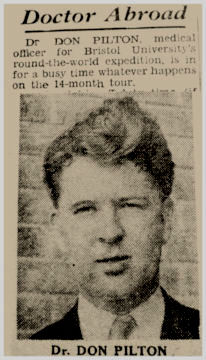 Tony
Morrison remembers.... 'Don was one of the founding members of the University
of Bristol Expeditions Society [UBES]. At the meeting when the Society was created
Don was one of three who put up a hand to join the Trans-Continental Expedition
and I recall turning to Mark Howell the originator and saying something like '
Phew .. now we have a Doctor in the team.... ' Tony
Morrison remembers.... 'Don was one of the founding members of the University
of Bristol Expeditions Society [UBES]. At the meeting when the Society was created
Don was one of three who put up a hand to join the Trans-Continental Expedition
and I recall turning to Mark Howell the originator and saying something like '
Phew .. now we have a Doctor in the team.... '
The
clipping is from The Bristol Evening World in August 1960 And
what a Doctor Don turned out to be for as far as he told me the six of us were
kept fit and travelling for thirteen months in all manner of climates, conditions,
long hours driving or at work. Not surprisingly Don was i/c our food and he had
to buy fresh meat and veg in a wide variety of local markets.
Apart
from being 'our medic' Don had a project for WHO financed by the Medical Research
Council and was called on by people we met on the way around the world.
Sharud
Iran 1960 - Don is centre 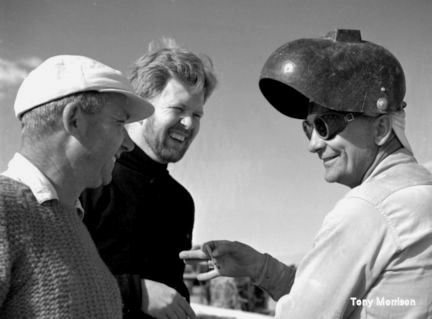 We
almost lost him to a oil pipe-laying company in Iran - they were short of a Doctor,
and again in Bombay, [now Mumbai] Don was offered a job with the WHO. We
almost lost him to a oil pipe-laying company in Iran - they were short of a Doctor,
and again in Bombay, [now Mumbai] Don was offered a job with the WHO.
In
both instances Don declined honourably as we had no contract between our team
apart from the goal of seeing the Expedition home to Bristol. 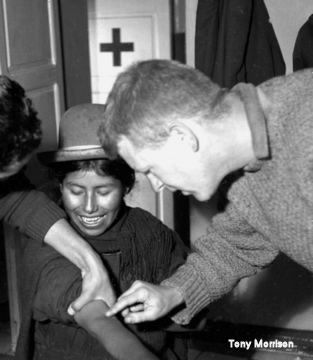 Bolivia
1961 and Don is helping at a UN / Bolivian medical post in the Andes mountains
at about 4000 m Bolivia
1961 and Don is helping at a UN / Bolivian medical post in the Andes mountains
at about 4000 m
Our
team project in Bolivia was sitting in with a UN - Bolivian government mission
actively helping indigenous communities with education, farming and health. [Acción
Andina] Don
worked with four communities and when asked which he enjoyed the most he chose
Pillapi near Lake Titicaca where he went duck shooting after work The
story of the expedition and some of Don's memories are on this site Back
in the UK On
return to England Don settled in Bath and over the following thirty years created
a flourishing practice as a GP with the NHS. I kept in touch by almost annual
visits until just before he died. Even
though he was seriously unwell we had a quick friendly spar about my reluctance
to 'go smart' for one reception to which I responded reminding him of a time in
some distant desert when I helped him to operate on himself. I could have jogged
your hand and you'd have been bollockless in a sea of sand.....Medical humour............
Don.... a marvellous doctor to be missed by many Medical
Officer with the University of Bristol Trans-Continental Expedition 1960-61
|
| |
| August
29th Opening of a 'Margaret Mee Room' in the Embassy of Brasil in London |
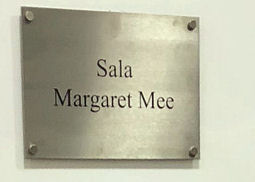
Tony
Morrison writes ....'It is almost thirty years since Margaret Mee died in a car
accident here in Britain. ....and it's more than thirty years since I was with
her on her last Amazon journey.... there's plenty about this story on the Nonesuch
site. So when
the staff of the Brasilian Embassy in London decided to dedicate a room in Margaret's
name and include two of my pictures from that last journey, not only was I honoured
but thrilled to remember such an Amazon adventure. Then
came the invitation from Ambassador H.E Eduardo dos Santos to be at the opening
which I knew was an impossible date due to family summer comittments... true ...!
was doubly sad not to be there as three who were especially close to Margaret
would be, including her niece Sonja Ukwuema who gave a short address. São
Paulo, Brasil 1951 or 2 - a garden scene Sonja
is the 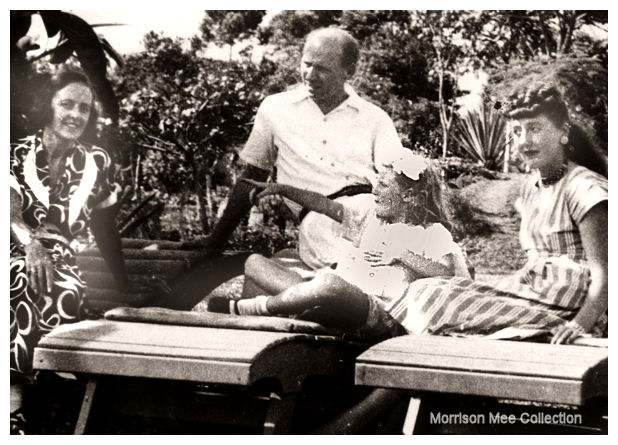 daughter
of Margaret's younger sister Catherine. Back in 1951 Catherine and her husband
Eugene Lahr were living in Campo Belo, a leafy suburb of São Paulo, Brasil
and Sonja was ...... let's guess.... about six at the time. daughter
of Margaret's younger sister Catherine. Back in 1951 Catherine and her husband
Eugene Lahr were living in Campo Belo, a leafy suburb of São Paulo, Brasil
and Sonja was ...... let's guess.... about six at the time.
Catharine was in the early stages of a debilitating illness and asked for some
family help. Eugene bought an outward ticket for Margaret who needed no second
bidding to move from London In
this picture taken in São Paulo and used in the Nonesuch book In
Search of Flowers of the Amazon Forests [1988] , Catherine is on
the left - Margaret then best known as Peggy with her 1950's lipstick and hair
piled high is on the right with Sonja on the seat beside her. Eugene who died
in Australia is standing. Catherine died in 1956 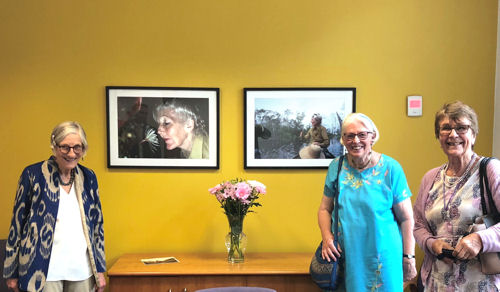 In
this picture from the Brasilian Embassy, on the left is Janet Prower the daughter
of Dora, Margaret's elder sister. On the right is Judy Brown ,widow of John Brown,
Margaret's brother - and Sonja is centre right. In
this picture from the Brasilian Embassy, on the left is Janet Prower the daughter
of Dora, Margaret's elder sister. On the right is Judy Brown ,widow of John Brown,
Margaret's brother - and Sonja is centre right.
I could not have wished for a better group with so many memories of a great Amazon
traveller.....What an incredible and productive life .... In
the wall picture on the left Margaret is face to face with the night flowering
Selenicereus wittii - The Amazon Moonflower while on the right is a picture
I took in an igapó or flooded forest of the Rio Negro about 120
kms upsteam from Manaus - the great city almost in the centre of Amazonia |
| 2018
August Around the world with a Wrayflex ll - Photographica World published
No 150 |
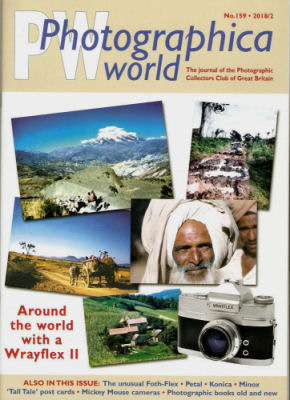 The
journal of the Photographic Collectors Club of Great Britain published the Wrayflex
story with many details of the lenses, colour film, successes and problems - it's
a story for photographers . The
journal of the Photographic Collectors Club of Great Britain published the Wrayflex
story with many details of the lenses, colour film, successes and problems - it's
a story for photographers .
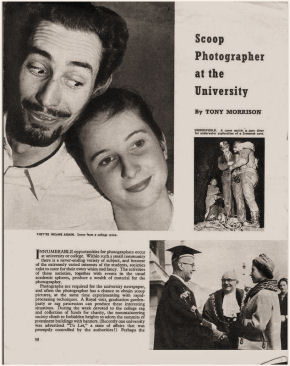 Tony
recalls ' It is my first published photographic story since 1960 when from
University the Amateur Photographer magazine... the UK's
oldest in the field gave me two pages for 'Scoop Photographer at University'.. Tony
recalls ' It is my first published photographic story since 1960 when from
University the Amateur Photographer magazine... the UK's
oldest in the field gave me two pages for 'Scoop Photographer at University'..
In
the bottom pic taken a the University door our Vice Chancellor greets the Queen
- 1958 'I suppose
that story and my university pastime kick started a lifetime's work' |
| |
| 2018
June 7th - Peter Krinks in Suffolk |
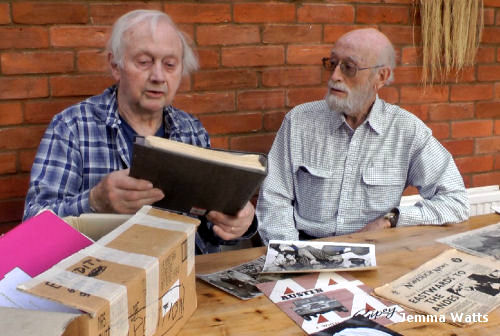 Peter
Krinks [right]the geographer and navigator for the Trans-Continental Expedition
1960-61 was with Tony at home in Suffolk to look through the expedition logs and
other documents sent in by June McKernan and Gwen Tutt. Peter
Krinks [right]the geographer and navigator for the Trans-Continental Expedition
1960-61 was with Tony at home in Suffolk to look through the expedition logs and
other documents sent in by June McKernan and Gwen Tutt.
'We
selected the most important for scanning to provide the basis of a 'collection'
Peter lives in Australia where he was a lecturer at Macquarie University in Sydney.
Peter gained a doctorate for his research in Papua New Guinea. '.....Peter ? -
he's fit ... he walked up the hill to our house carrying a massive rucksack ...
and a smile' Picture
by Jemma Watts |
| |
| 2018
May 30th Launch of My Wrayflex World |
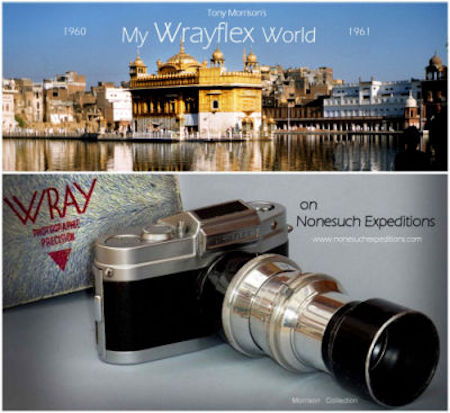 At
the end of last year Tony gave a talk titled Six of one and Half a Dozen
of the Other to UBES - the University of Bristol Expeditions Society of
which he is one of the founders. At
the end of last year Tony gave a talk titled Six of one and Half a Dozen
of the Other to UBES - the University of Bristol Expeditions Society of
which he is one of the founders.
Preparing
the talk was the impetus for Tony to restore the colour photographs he had taken
during the 1960-61 Expedition. Unfortunately the task was not completed in time
for the talk Now
resred the pictures
are incorporated in My Wrayflex World for this website. Around
the world with a Wrayflex camera The
story is in four parts covering the camera and a Photo-Diary of the journey with
short accounts for over sixty pictures. 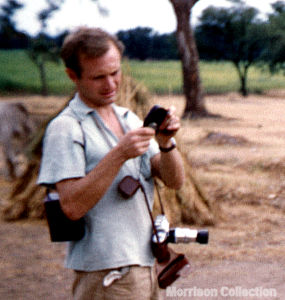 The
collection is unique as the colour, now almost sixty years old is substantially
accurate. Here is the world in colour sixty years ago - India just twelve years
after Independence - Bolivia just eight years after the National Revolution. The
collection is unique as the colour, now almost sixty years old is substantially
accurate. Here is the world in colour sixty years ago - India just twelve years
after Independence - Bolivia just eight years after the National Revolution.
Also,
the Wrayflex ll camera Tony used was one of less than three hundred made by the
Wray Optical Works in Bromley Kent. There
is no accurate information on the numbers produced but as the best guesstimate
- about 2450 of the early models were made - top picture and less than 300 of
the Model ll - think...Apple produced over 70 m iPhones in the last quarter of
2017 Here
on the left in India, Tony is using the Wrayflex ll and the Wray Lustrar 135mm
telephoto lens and below right in Bolivia with a Wrayflex ll and Wray Uniilux
50 mm lens . The pictures are on Kodachrome 35 mm film ASA 12 A
mirky provenance 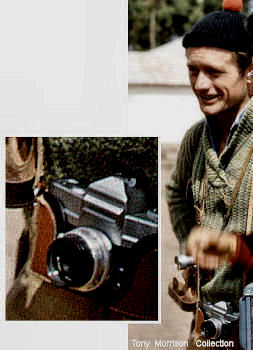 The
series includes a brief historical account of the Wrayflex camera which among
enthusiasts is known as 'The first British 35 mm SLR' [Single Lens Reflex] But
Tony is convinced it came from a German design scooped up by British experts in
the ruins of Nazi Germany soon after WWll The
series includes a brief historical account of the Wrayflex camera which among
enthusiasts is known as 'The first British 35 mm SLR' [Single Lens Reflex] But
Tony is convinced it came from a German design scooped up by British experts in
the ruins of Nazi Germany soon after WWll
To
mark the launch of the story a small group of photographers met for a Ration Book
Supper hosted by Marion and Tony. Only Tony and Marion were of the Wrayflex era
but the others brought a collection of old cameras and photos - the story was
mailed worldwide. More
- My
Wrayflex World Scroll
down for the
talk |
| 2018
February 3rd, Ray Sutcliffe, died in London |
| |
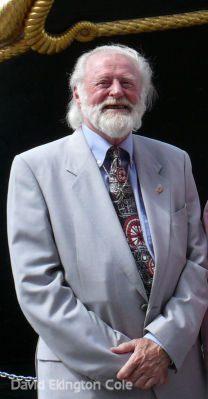 It
is with great sadness that we have just heard of the death of Ray Sutcliffe. We
received a 'phone-call from his friend Emma St John-Smith who told us how Ray
had been due at a supper party and hadn't turned up. 'That's unlike him' they
thought, but he had been struck by a heart attack. It
is with great sadness that we have just heard of the death of Ray Sutcliffe. We
received a 'phone-call from his friend Emma St John-Smith who told us how Ray
had been due at a supper party and hadn't turned up. 'That's unlike him' they
thought, but he had been struck by a heart attack.
Our
memories of Ray will forever be tied to Brunel's iron ship the SS Great Britain.
In 1969 the rusting hulk was beached in the Falkland Islands and we were heading
out to film for the BBC Natural History Unit when we had a call from Chronicle
the BBC Archaeological and History Unit. 'Could we add a few shots of the Great
Britain?'… 'OK that's fine' we said and within twenty-four hours Ray was
on his way to join us.
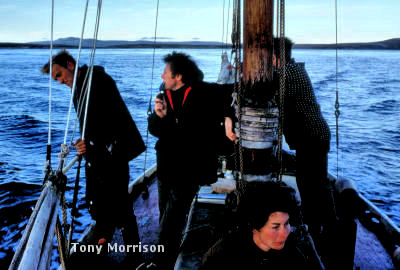 Here,
Ray is smoking his beloved pipe on the boat of Roddy Napier [left] and making
an inter-island journey in the West Falklands from New Island to Carcass Island. Here,
Ray is smoking his beloved pipe on the boat of Roddy Napier [left] and making
an inter-island journey in the West Falklands from New Island to Carcass Island.
Ian Strange
a wildife artist /conservationist is on the right and Marion Morrison is in the
foreground right. 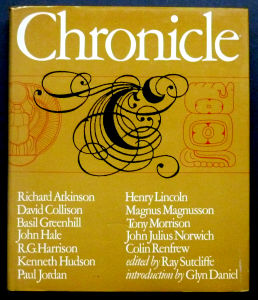 From
that time and for many years we enjoyed a fascinating friendship and working association. From
that time and for many years we enjoyed a fascinating friendship and working association.
With Ray we filmed
the salvage of the Britain in 1970 [The Great Iron Ship]. Then in
1978 Ray produced our Nasca Lines Peruvian mystery [Pathways to the Gods]-
such memories - Ray just couldn't grasp the philosophy of straight lines. In
the 1980s Ray edited an anthology of Chronicle programme stories and I helped
with a few fill-in scenes at Sutton Hoo the Anglo Saxon burial just two kilometres
from where we live. In
later years we met at Falkland Island and Great Britain reunions. In 2012 we produced
a book together titled Saving The Great Britain and gave all the rights
to the SS Great Britain Trust to help the upkeep of the old ship. A
dedicated saviour of the Great Britain It
can be truly said that Ray's efforts made the return of ' The Britain' a National
Event - Ray's BBC film was televised in three versions beginning with the hulk
in the Falkands to the night when the old ship was nudged into the dock where
she is today. HRH Prince Philip was on the deck. A crowd of over one hundred thousand
lined the Avon river banks in Bristol and the Press covered the story countrywide.
Raymond Ernest Sutcliffe [MA Cantab] FSA, BBC TV producer and director,
Committee member of countless marine societies including the SNR [Society for
Nautical Research]. Died January 31st 2018. |
|
| 2017
October 31st Bristol, England - At the University
of Bristol |
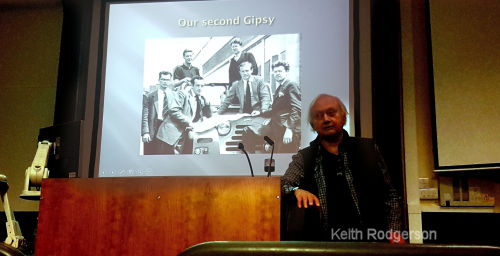 Six
of One and Half a dozen of the Other Six
of One and Half a dozen of the Other Tony
Morrison tells the story of the University of Bristol Trans-Continental Expedition
1960-61 at an event arranged by the Expeditions Society [UBES] The
orignal team was six and since 2002 three have died - Mark Howell the originator
of the idea, Malcolm McKernan, the writer / admin leader and Roger Tutt, the youngest
and business manager. Read more about the team and expedition on this site The
idea In
1957 Mark suggested a journey to India using his old car, a Standard 9. It was
a fallback option in the event we failed our exams. But we passed and it was not
until two years later when disenchanted with the thought of a permanent job that
Mark found a sponsor - the Austin Motor Company. And so the idea gained traction.
Malcolm McKernan a writer for Nonesuch News the Union newspaper and its Editor
Mike Gorman produced a front page double page spread for the January 29th edition
in 1960. 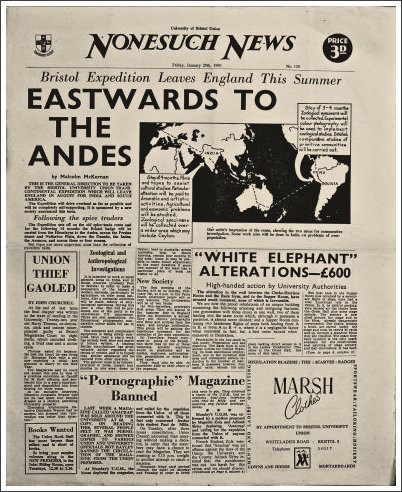 The
publicity quickly led to the formation of the Expeditions Society on Sunday 31st
January 1960 and we gained three new members, Roger Tutt [economics], Peter Krinks
[geography] and Donald - always. 'Don'.... Pilton a doctor. The
publicity quickly led to the formation of the Expeditions Society on Sunday 31st
January 1960 and we gained three new members, Roger Tutt [economics], Peter Krinks
[geography] and Donald - always. 'Don'.... Pilton a doctor.
Just
hard work It
was not all downhill from there ..... just hard work. But in less than six months
the project was ready to take-off with senior figures from the University adding
credibility - the Vice Chancellor was Chairman of the Finance - nothing less and
from the City, the Lord Mayor was the Expedition's patron. We
had two academic projects - one in small village in India working in a alongside
the Ghokale Institute [GIPE in Poona - now Pune] . The second project was in Bolivia
to see how a Bolivian Government Programme for health and education was helping
four small communities - three were in the Andes Mountains and the fourth in the
country's immense lowlands. The programme known as The Andean Programme was backed
by the UN and the ILO. A
third and totally different project was created by the Lord Mayor of Bristol who
gave us twenty seven letters to be delivered to mayors of cities along our route
and especially to those in North America with strong Bristol business connections And
the title for this event? Six
of One and Half a dozen of the Other was chosen by Meg Clark and the UBES
committee who hosted the evening. In August 1960 Malcolm McKernan wrote a piece
for Bristol's newspaper, The Western Daily Press.
Secrets Revealed of plan to visit Bolivia and Indian village ...... ' For
more than one reason "six of one and half a dozen of the other" could
be the motto of the University of Bristol Expeditions Society Trans-Continental
expedition (1960-61), which will leave Bristol next week' Malcolm's
writing was thoughtful . How? Why? Where? Who? It's on this site and well worth
a read. My thanks to the UBES committee and especially to Val Ismaili for his
introduction tonight. Great guys......... and good travelling... Footnote
Mark Howell was a founder of Nonesuch Expeditions back in 1962 and his story is
in the Our Story of the Nonesuch Expeditions pages |
| 2017
July |
| Return
to the Quantocks - The third visit |
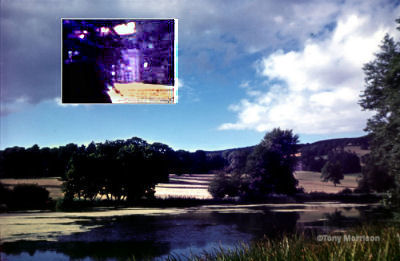 Almost
a year to the day since Tony's 80th birthday he returned to the Quantocks in search
of a story he uncovered in his collection of early colour pictures.. Almost
a year to the day since Tony's 80th birthday he returned to the Quantocks in search
of a story he uncovered in his collection of early colour pictures..
In a shot taken in 1955 on Ilford Colour D 35mm Tony spotted the corner of
a large house he could see in just one other picture in his collection. '
The scan of the early film was dark and I asked Evelyn Whitfield who is scanning
all my old pictures for a re-scan. And Bingo - there it was........... a house
hidden in the trees The
view here is across a lake created for the 19th Century Cothelstone Park on the
southern flank of the Quantock Hills near Bishops Lydeard,Somerset. 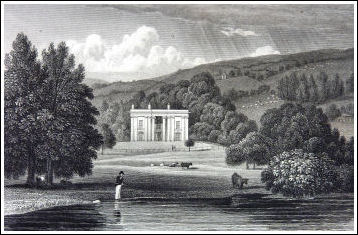 A
search A
search
I
soon discovered that the building was Cothelstone House built in the 1800s and
demolished in the late 1960s by when I was far from Somerset and working in television. The
scan made in 2016 from the Ilford film set me on the trail of the house and its
history. Again, obviously first turning to the web though with little simple success. The
return 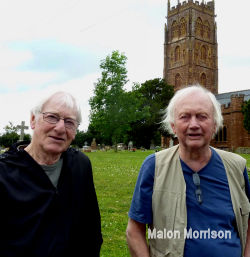 So
with Marion who took this picture I met David Cole my old friend from schooldays. So
with Marion who took this picture I met David Cole my old friend from schooldays.
We had sat navved
to a 'pub lunch at the historic Lethbridge Arms in Bishops Lydeard about
three kms from the location. We knew the village from our cycling days of the
mid-1950s By now
if you have read some of the pages on this site you will know that David who is
married and lives in London has spent much of his working life taking pictures
of food under the name of David Elkington Cole. In the photo David is on the
left. So
what better excuse for a mild adventure. Here we had a wild goose chase for The
House that Vanished and some excellent Quantock grub - and of course, the
very local brew ............It's from Bishops Lydeard 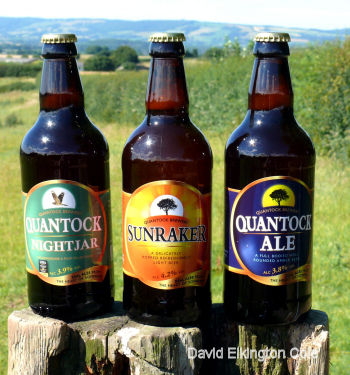 The
story of Cothelstone House and the Park will be in the Return to the Quantocks
pages so look out for it. The
story of Cothelstone House and the Park will be in the Return to the Quantocks
pages so look out for it.
Unfortunately
I'm unable to post a download of the beer so David shot some tasters. Will
we make a fourth visit? Try keeping us away. ' |
| |
| 2017
February |
| Fifty
Years Ago |
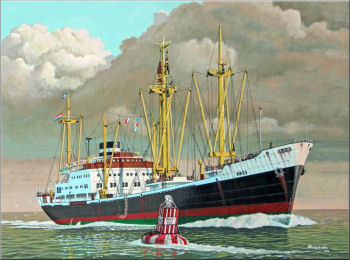 Nonesuch
is about the journeys, books and films of Tony and Marion. And it's about the
friends they have travelled with or met along the way. Nonesuch
is about the journeys, books and films of Tony and Marion. And it's about the
friends they have travelled with or met along the way.
This
page covers events in February 1967 needing a special mark. Why? Let me recap
- Tony had encircled the globe with the University of Bristol Expedition, he had
filmed in the Middle East and South America for BBC TV and in 1963 had
met Marion in Bolivia. More
filming followed for the next three years and then in 1967 they set out together
for a three year journey filming wildlife along the Andes mountains They
made bases in Lima Peru, La Paz Bolivia, and Bogota Colombia. For this long Andean
journey they took their own SWB Land Rover and that's where this story begins.
The Land Rover
was shipped from Liverpool UK to Lima by cargo boat. Marion with seventeen pieces
of luggage also travelled by sea but from Holland in a 5,700 tonnes cargo-passenger
ship, the Ares of the Royal Netherlands Steamship Company [KNSM] Tony
had the luxury -if you can call it that, by taking the air route via Mexico where
he had picture and filming assignments.
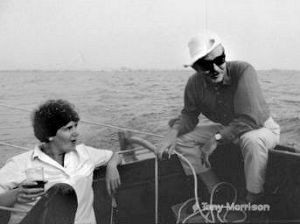 Marion travelled on Ares as far as Callao the port for Lima with Sue Mann
an old friend from her home town of Woodbridge in Suffolk, UK.
Marion travelled on Ares as far as Callao the port for Lima with Sue Mann
an old friend from her home town of Woodbridge in Suffolk, UK.
Sue
in Callao Bay Peru with Harry Knapp - left Sue
had travelled in South America in 1965 with Tony and Mark and had made many friends
there so decided to take a a two year job teaching in a school in Santiago, Chile
- after Callao the Ares was headed down the west coast of South America
to Valparaiso the port for Santiago. Sue Marion and Tony next met-up again in
Santiago for Christmas .
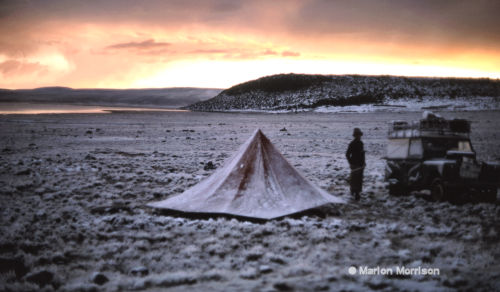 Our
Filming Journeys began By
the end of February 1967 our Land Rover was 'out of the Callao Customs shed' and
the filming journeys had begun. Here
we are camped at 4,397m by The Yaurihuiri Lakes near Puquio 400 kms southeast
of Lima . Yaurihuiri is now recognised as a 'wetland' with a special status. We
were there for the abundant birdlife including flamingoes and to capture the sunrise
as an 'opener' for a film . Marion took the picture. That
Hat We
hadn't bargained on overnight snow and it was a bonus.I
am wearing The Hat - see my 80th - below on this page The
Anniversary Reunion Recently
we met with Sue over
a few glasses of Chilean vino to visit memory lane complete with its recordings
of the Christmas party Sue held in Santiago. Stories about the Ares, the
Panama canal and and cargo-ship life featured highly as such leisurely times are
past. Sue continued her life teaching and Chile has drawn her back a couple of
times, most recently with her flat-sharing friends of the 1960s. Looking
back to our three years of filming and writing which came with two unexpected
filming visits to the Falkland Islands [Islas Malvinas] we feel those Land
Rover journeys covering close to 150.000 kms were exceptional - the roads were
empty and the towns were small, welcoming places. I still recall vividly the tiny
hole in the wall shop-cum-cafe in Puquio at 3,120m where in the glow of a kerosene
light we supped mutton and quinoa soup - that was aeons before quinoa
became fashionable - a memorable soup it was too. |
| |
| Valete |
| January
5th 2017 Roger Tutt CMG - died in Oxenhall, Gloucestershire |
| |
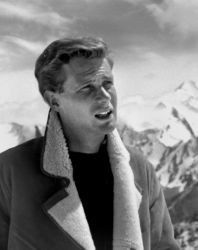 Roger
Tutt, one of the six graduates from the University of Bristol Trans-Continental
Expedition of the early 1960s died at home in Oxenhall, Gloucestershire on January
5th 2017. Roger
Tutt, one of the six graduates from the University of Bristol Trans-Continental
Expedition of the early 1960s died at home in Oxenhall, Gloucestershire on January
5th 2017.
After
a globe-trotting distinguished career with the British Diplomatic Service, Roger
retired close to where he grew up. Nowhere was he happier than in the little village
where he was a a Trustee for the Parish Hall or out in the countryside 'doing
a spot of coppicing' or filling a barn with wood for the winter. The
story of how Roger came to join the Expedition is in Eastwards to the Andes
written by the late Malcolm McKernan for the University Union paper in January
1960. In this picture Roger is on the slopes of Mount Chacaltaya in the Bolivian
Andes mountains at 5,200 m. in early 1961.
Eastwards to the Andes The full story of the expedition and Roger's part
as 'Business Manager' - his return to India in 2000 and many news clippings are
on this site.
|
|
December
31st 2016 Alfredo La Placa - died in La Paz Bolivia |
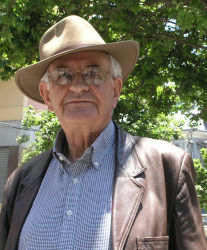 Alfredo
La Placa who died in Bolivia on December 31st 2016 was a great friend of Nonesuch.
Known as 'Freddie' to Tony and Marion and their colleagues Mark Howell and Allan
Reditt, he joined two filming journeys in 1963 and another in 1967. Alfredo
La Placa who died in Bolivia on December 31st 2016 was a great friend of Nonesuch.
Known as 'Freddie' to Tony and Marion and their colleagues Mark Howell and Allan
Reditt, he joined two filming journeys in 1963 and another in 1967.
Freddie
was an artist and took great inspiration from the many beautiful mineralised rocks
of his native country. For fifty years he added enormously to our understanding
of Bolivian history and art. During his career he was appointed Director of Bolivian
National Museum of Art and National Director of Bolivian Museums. His works were
exhibited throughout Latin America and in the USA. By
the time of his death he had become one of South America's foremost artists and
we know our memory of him will last a long time. See
Why Bolivia? .
|
|
| November
5th 2016 Allan Reditt - died in France |
|
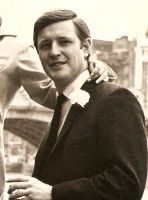 Allan
was one of Tony's great schoolfriends from Taunton, Somerset who in 1963 joined
the first Nonesuch Expeditions filming journey to South America. For the trip
which made seven films for BBC TV, Allan acted as Business Manager watching over
the production arrangements. Allan
was one of Tony's great schoolfriends from Taunton, Somerset who in 1963 joined
the first Nonesuch Expeditions filming journey to South America. For the trip
which made seven films for BBC TV, Allan acted as Business Manager watching over
the production arrangements.
After
the trip Allan worked as a journalist in London before joining Reuters for a long
career with many overseas postings. In 1964 Allan married Jacqueline Chester from
Kent who was with Marion Davies working with UNDP in Bolivia. Tony and Marion
married in 1965 and the photo of Allan was taken at their wedding. Allan
Reditt 1936 - 2016 The full account of Allan and Tony's long friendship
and of the 1963 journey to South America to make films for the BBC. Picture
by David Cole 1965 |
|
| July
2016 Tony Morrison at 80 returns to the Quantock Hills in Somerset |
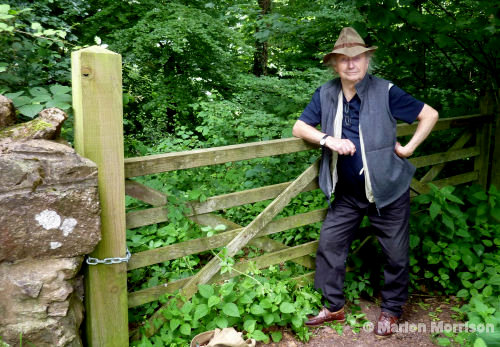 A
moment to look back A
moment to look back
After more
than half a century of travelling to some of the world's wildest places.... and
to some of the most exotic.... and to some of the most depressed, I felt that
my 80th birthday should be a time to look back and see where I began. And then
quickly create another project. A
Grand Party? The
idea of a grand party appalled me..... ' a ghastly thought ....so with my wife
Marion we planned a day of celebration in the Quantock Hills of Somerset.
My early life was spent in Somerset and Marion is from East Anglia so I would
get the chance to show her places where I took my first photographs. We met in
1963 in the Andes mountains of Bolivia in far different scenery. The
Hat At the
top of my travel gear was a felt hat I had bought in a market in Cusco in Peru
in 1964 when making a film for the BBC TV. The hat came with me to Espirítu
Pampa - the actual Lost City of the Incas and then it survived an exhilarating
journey on a balsa raft through the Pongo de Mainiqué rapids of the Urubamba
river downstream from Machu Picchu. Many of the stories are on this site
And the hat was
with me in 1967 when with Marion I was in the southern Bolivian Andes filming
Land Above the Clouds about the rare wildlife for Survival, Anglia Television's
prestigious natural history series. Then
in 1969 the hat came along when we made a BBC TV film in the forests of the Manú
river. Our film ' A Park in Peru ' was a landmark in conservation as one
of the first roads into Amazonia was being driven through the forest and rare
widllife was threatened. After that it was put in a cupboard and for years I thought
it was lost. Not so. 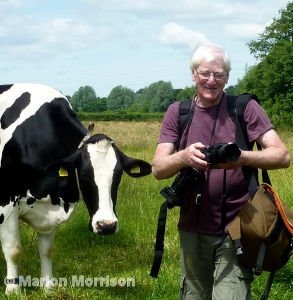 Picture
it .. Picture
it ..
So was
the Quantocks trip to be for just the two of us. Not so. I invited David Cole
an old friend from Bishop's Hull the village where I lived, as we had explored
the hills and began our photographic careers at about the same time. Marion took
the pictures. One is in Holford Combe and as it was mid-summer the trees were
filled with a rich abundance of leaf. David and the very inquisitive cow were
in a field in our old village. To
complete the scene I should have used 'binder twine' around the trouser legs below
the knee once common on local farms. But with or without the binder twine we had
some traditional scrumpy, the local cider. Mildly yellow and turbid with
apple, the sacred juice was spot on - it hit all the right buttons. Tinned
Spam Marion
had prepared a 1950s picnic spread for lunch on Cothelstone Hill some 332 metres:
it's not the highest point but my favorite as the 360 degree view is spectacular.
But not for an easy panorama on my 1950s Kodak Retina 1a camera.
The menu included Spam- tinned pork of the frugal post war years, Shippams Fish
Paste - another favourite from the 1950s, locally baked bread, Somerset butter
and cheese, some local fruit and jam. A cake? Forget it. We had our eyes set on
a cream tea in The Quantock Tea Rooms in Nether Stowey. The taste of clotted cream
is unforgettable. 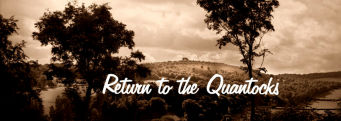 I
have put more about the Quantocks in our Feature pages as Return to the
Quantocks. Pictures and stories, including David's memories of the village
will come later. David is married and living in London where he works as David
Elkington Cole. I
have put more about the Quantocks in our Feature pages as Return to the
Quantocks. Pictures and stories, including David's memories of the village
will come later. David is married and living in London where he works as David
Elkington Cole.
Try
it - see Return
to the Quantocks
|
| Launch
of Nonesuch Silver Prints website March 2016 |
|
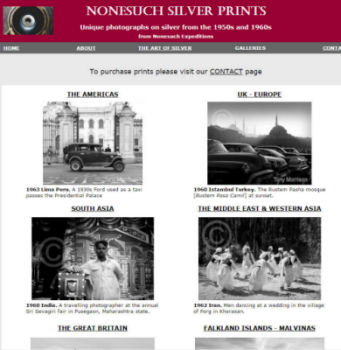 See
some of our collection of black and white photographs See
some of our collection of black and white photographs
For
the past couple of years we have been selecting the most evocative images from
our early collections.
The 1950s are mainly from Somerset and my years as a student. The early 1960s
pictures come from an around the world expedtion with five other graduates. And
from the mid-1960s through to 1970 are when we travelled, mostly together in South
America. Each
negative has been cleaned, scanned and stored in an acid free wallet. Each scan
was made at high resolution so we can print on traditional silver gelatin paper...
in fact only silver gelatin prints will be made so ensuring exclusivity and superb
longevity. Each
picture is accompanied with a short description and camera details. Where possible
the exposure and film data have been added. Nonesuchsilverprints.com |
| Return
to the Silk Road - September 18th 2015 |
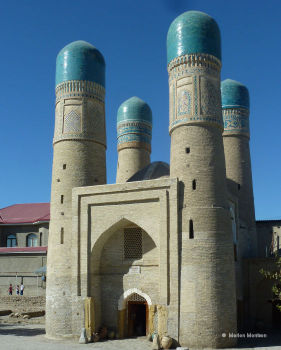 Fifty
three years after leaving the Silk Road in the deserts of Khorasan, Iran,Tony
Morrison returned to the Asian steppes with Marion. Most of their life together
has been spent in Latin America but one idea Tony was working on in 1962 was never
completed. During the time when Soviet Russia dominated large parts of Central
Asia the fabled religious centres of Bukhara and Samarkand were not open to visitors
especially television teams. Tony was working as a cameraman director for two
great travellers of their day, Ralph Izzard and Tom Stobart and the best they
could do at the Soviet border was to dream of the Golden Road to Samarkand. Fifty
three years after leaving the Silk Road in the deserts of Khorasan, Iran,Tony
Morrison returned to the Asian steppes with Marion. Most of their life together
has been spent in Latin America but one idea Tony was working on in 1962 was never
completed. During the time when Soviet Russia dominated large parts of Central
Asia the fabled religious centres of Bukhara and Samarkand were not open to visitors
especially television teams. Tony was working as a cameraman director for two
great travellers of their day, Ralph Izzard and Tom Stobart and the best they
could do at the Soviet border was to dream of the Golden Road to Samarkand.
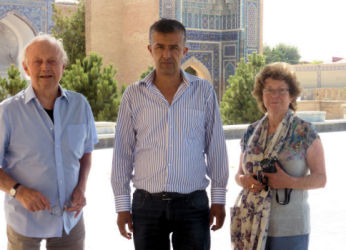 Tony
Morrison writes.. Early in 2015 we decided to travel to Uzbekistan where the
extraordinary monuments to many civilisations have been preserved. Tony
Morrison writes.. Early in 2015 we decided to travel to Uzbekistan where the
extraordinary monuments to many civilisations have been preserved.
We
felt it should be an Izzard - Stobart Memorial Journey as both had died some years
back. Our account will appear as a Feature Story on this site and we are indebted
to our Uzbekistan guide and interpreter Kamalov Shavkat - Kamal - for easing
us through the convoluted history of a very remarkable land. Here
on the left is the Char Minar madrassah in Bukhara. Built in the 19th century
it is certainly not the oldest of the World Heritage sites but with its four minarets
/turrets it has become a symbol for the city. See
Return to the Silk Road |
| Trevor
Stephenson died May 16th 2015 - he made the 'Ton' |
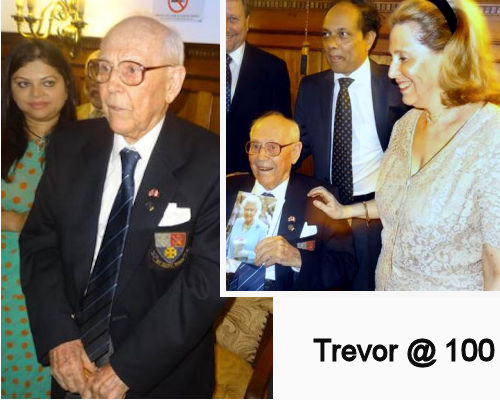 Trevor
Stephenson the oldest of our correspondents died in May this year only a couple
of months after reaching his 100th birthday' Trevor
Stephenson the oldest of our correspondents died in May this year only a couple
of months after reaching his 100th birthday'
Tony
Morrison writes ' I met Trevor for the first time in Lima in 1979
when I was on a production recce for a BBC Television film about a train jouney.
Trevor was a mine of information about trains especially those crossing the central
Andes mountains. Eventually
Trevor was included in the film and 'interviewed' in as the train chugged up the
Central Railway at that time the world's highest. In
2012 Trevor asked me to publish his memoirs online - to be free of charge and
to include snippets from his life in South America. The project took two years
to complete during which we were in touch by e-mail almost daily - with Trevor
himself writing and sending from Lima. The final chapters were uploaded in early
2014. From Cranleigh
School in Surrey, England, at that time a boys school, Trevor made a career in
the world of shipping and trading with South America. Much of his early life was
spent in Brasil along the Amazon river. We
were in touch just before his 100th birthday as he was to have a celebration party
at Lima's historic Phoenix Club - founded in 1879 at the height of the
War of the Pacific involving Peru, Bolivia and Chile. The
British Ambassador to Peru, Mr. Anwar Choudery and his wife Momina were invited
to the party and Trevor was presented with a telegram / card of congratulations
from Her Majesty Queen Elizabeth in London. In the picture with Trevor holding
the card, his daughter Barbara is on the right. Trevor
Stephenson 1915 -2015 - his memoirs are in 18 chapters in Reminiscences
of my Sixty years in South America |
| Launch
of Nonesuch Silver Prints March 15th 2015 |
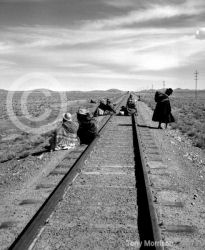 In
our first major initiative since the website was created in 2005 Nonesuch Silver
Prints went live in March. In
our first major initiative since the website was created in 2005 Nonesuch Silver
Prints went live in March.
A
small selection of black and white pictures from the early collection of Tony
and Marion Morrison are presented in 'Galleries' attached to this site. Eventually
as many as three hundred pictures from silver halide images will be online and
some will be available as silver halide paper prints. This
picture of a railway line across the Altiplano - the high plain of the Bolivian
Andes was made on a Microflex twin lens reflex camera on Kodak silver halide fim
in 1961. More
details are with the pictures in Galleries |
| Return
to the Cauldron
- Romania
October 2014 |
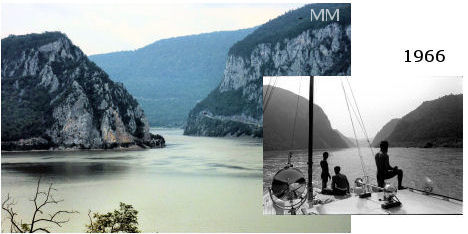 Here
at the Cazan gorges on the
river Danube the picture is from Romania and Serbia is on the right. Here
at the Cazan gorges on the
river Danube the picture is from Romania and Serbia is on the right.
In 1966 Tony Morrison was the film-maker on a small motor yacht September Tide
making a Cold War journey up-river - MORE Lost
in the Danube
In Features on this site. On
that journey the fast flowing water boiled around ship - hence 'Cazan' variously
translated as cauldron or boiler In
1971 a dam was completed about 35kms downstream from the narrows in these pictures
and the water rose by 33m. The Cazan stopped and a huge lake spead outwards affecting
the river for about 400kms upstream.
Tony with Marion returned to the spot to see the changes. He said ' perhaps
it's a bit late for a scoop but we have been tied up in South America almost non-stop
since the September Tide adventure. Read the story in Afterthoughts - 'Lost in
the Danube' |
Launching
the University of Bristol Trans-Continental Expedition 1960 - Michael Gorman dies
2013 |
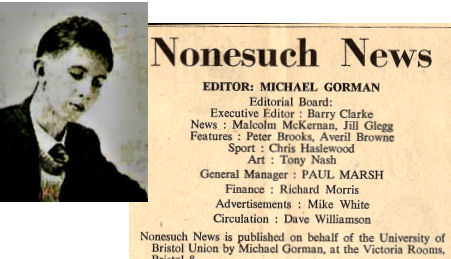 At
about the time Malcolm McKernan died in February this year (2014) we heard that
Michael (Mike) Gorman the Editor of Nonesuch News in 1960 had died [in
2013]. At
about the time Malcolm McKernan died in February this year (2014) we heard that
Michael (Mike) Gorman the Editor of Nonesuch News in 1960 had died [in
2013].
Mike
Gorman saw 'a good story' in the 'round the world expedition' and gave it a Front
Page lead, a superb headline and a double page centre opener. Malcolm the writer
was on the 'News' Editorial Board and became the Reporter on the expedition, and
then very soon the Administrative Leader. Tony
Morrison remembers 'Mike was a true foot-in-the- door reporter - he sensed
good stories. I took pictures for the News and one day Mike said ' how
about London at the weekend - for the Express? With expenses?' He had a scoop
Royal story and an on-going deal with the Daily Express. But like many such stories
it didn't gel - Oh Well - better luck next time. To
read more about Michael Gorman's amazingly successful career look on the web for
a PDF |
March
6th 2014 Surrey, England - A memorial service for Malcolm Towers McKernan whose
skill as a writer launched the University of Bristol Trans-Contintinental Expedition
1960-61 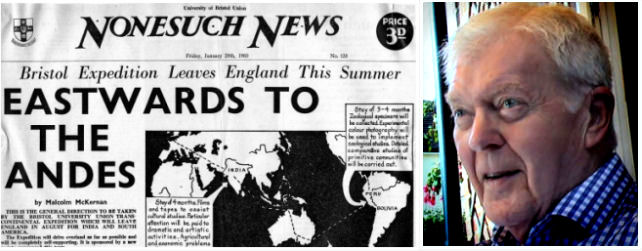 Malcolm
died aged 86 on February 16th after a long illness. He had suffered from Parkinson's
disease for many years and latterly developed Lewy Body dementia [LBD]. About
120 friends and family gathered to remember him at St. Peter's Church, Hersham. Malcolm
died aged 86 on February 16th after a long illness. He had suffered from Parkinson's
disease for many years and latterly developed Lewy Body dementia [LBD]. About
120 friends and family gathered to remember him at St. Peter's Church, Hersham.
Malcolm's short working life was with the British Foreign and Commonwealth Office.
He joined late after surviving many years as a student at various universities.
It was in Bristol
where Malcolm studied drama and playwriting that he found his way with news reporting
and became a features writer for the student's union newspaper Nonesuch News.
That post brought him into contact with Tony Morrison a photographer for the paper
and who with a fellow graduate Mark Howell was seeking to launch an expedition
to travel around the world. 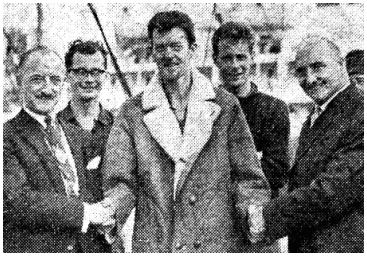 And
so the University of Bristol Trans-Continental Expedition became a reality. The
team appointed Malcolm, then almost 33 as Administrative Leader and he did most
of the formal handshaking on the journey - here he is on the Avonmouth [Bristol]
quayside with The Lord Mayor of Bristol Alderman
Charles Smith [left] and Alderman Hugh Jenkins the deputy Lord Mayor [right]
on the day the team arrived home. Roger Tutt behind on Malcolm's left spoke at
the memorial service. Mark Howell behind on his right died in 2002 - for more
about Mark see this site.. And
so the University of Bristol Trans-Continental Expedition became a reality. The
team appointed Malcolm, then almost 33 as Administrative Leader and he did most
of the formal handshaking on the journey - here he is on the Avonmouth [Bristol]
quayside with The Lord Mayor of Bristol Alderman
Charles Smith [left] and Alderman Hugh Jenkins the deputy Lord Mayor [right]
on the day the team arrived home. Roger Tutt behind on Malcolm's left spoke at
the memorial service. Mark Howell behind on his right died in 2002 - for more
about Mark see this site..
Of
the other team members Tony Morrison was at the memorial service and recalled
some of their experiences. Don Pilton the team's doctor could not be there and
Peter Krinks who has settled in Sydney Australia sent these thoughts. If
memory plays fair, I first saw Malcolm in 1958, on stage in the Drama Department
at Bristol University where he was a post-graduate fellow. With his tall, fair,
crew-cut appearance he was a convincing Swedish businessman. (The play may have
been `Daylight and champagne', by Derek Coltman.) Our paths crossed intermittently
on and off-stage thereafter until 1959, when I joined him and four others as members
of the planned transcontinental expedition. Contact was constant during the trip,
of course, as we were in the same vehicle for thirteen months. I was very grateful
for his steady eye and hand on the wheel when he brilliantly avoided a collision,
squeezing between a wooden ox-cart and a large cargo truck on a narrow Indian
road. I
remember him as a courteous man whose gift for interesting talk reflected his
diverse education and wide interests. Peter
Krinks - March 2014. Malcolm's
Expedition reports for the Western Daily Press, Bristol are on this site
- follow the Expedition pages. One special account about poverty in Peru is available
for the first time since it was published in the original Nonesuch
News in November 1961— READ
HERE |
| |
November
26th 2013 Iquitos, Peru — At 98 Trevor Stephenson returns to the Amazon to
launch a new book 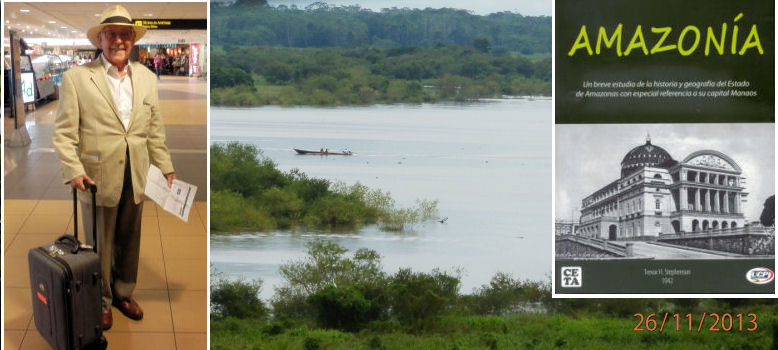 Trevor
has been back to Iquitos a couple of times since he was woking there in 1946 for
the Booth Steamship Co Ltd Trevor
has been back to Iquitos a couple of times since he was woking there in 1946 for
the Booth Steamship Co Ltd
The Booth name dates back to the 19th century and is linked to the support of
many of the companies trading along the river.
You can read Trevor's Reminiscences
in Nonesuch Extra. But this special return journey was to launch a bookTrevor
wrote when he was in the Booth office in Manaus in 1941-2. The
original work is a massive volume filled with paper memorabilia of all kinds some
of which will be reproduced in Nonesuch Extra in 2014. The book just published
is a Spanish language version of the original text and is the only commercially
available edition. Amazonía
- A short study of the history and geography of the State of Amazonas with special
reference to the capital city of Manaus is published in Iquitos by the Centro
de Estudios Teológicos de la Amazonía |
| |
October
2013, La Paz, Bolivia - Tony and Marion Morrison were in La Paz for a reunion
with old friends from the 1960s. Tony and Marion met in La Paz in 1963 and since
then have worked together making television films, writing and publishing books.
They are now creating a cloud archive of their Bolivia collection including more
than fifty years of photography. 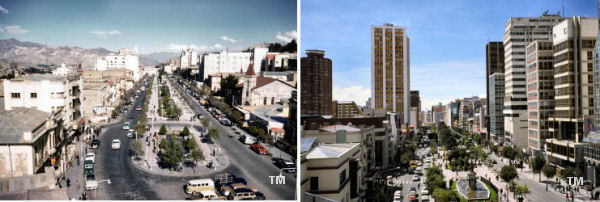 They
met close to the Prado, an open place in the central part of the city - here in
the picture on the left and now surrounded by high buildings. They
met close to the Prado, an open place in the central part of the city - here in
the picture on the left and now surrounded by high buildings.
Tony
was in Bolivia with Mark Howell, a co-founder of Nonesuch Expeditions, and an
old school-friend Allan Reditt making films for a BBC Adventure series.
Marion was there as a Graduate Volunteer with Jackie Chester from London to help
with a UN programme 'Accion Andina'. Bolivia
is twice the size of France and the UN programme extended to bases in four distant
parts of the country. 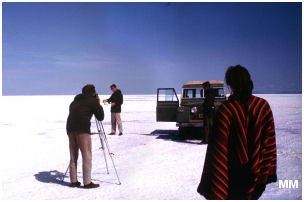 The
stories for the Nonesuch films took Tony, Mark and Allan to some of the far flung
corners of Bolivia and the team very quickly became five. Here they are filming
on the Salar (salt pan) of Uyuni in 1963 when it was untrodden and still to be
'discovered' for tourism. The
stories for the Nonesuch films took Tony, Mark and Allan to some of the far flung
corners of Bolivia and the team very quickly became five. Here they are filming
on the Salar (salt pan) of Uyuni in 1963 when it was untrodden and still to be
'discovered' for tourism.
The
account of this early journey across the salar was told in the BBC film The
Treasures of Chuquisaca [1963] and in Mark's book Journey Through a
Forgotten Empire [1964] Allan
married Jackie in 1964 and after a life of world-wide journalism they settled
in France. Mark who died in 2002 married and created a tech- business in Bristol,
England. [see About Nonesuch]. The
Treasures of Chuquisaca [1963] led Tony, Mark and later with Marion to five
long journeys to the far south of the Bolivian Andes mountains into an area known
as Lipes [Lipez]. The pictures and other records made in those years are in our
Lipes Collection. |
| |
| September
2013 Michael (Mike) Gorman - one time editor of the University of Bristol
Union newspaper Nonesuch News died. See late 2014 and Malcolm McKernan for the
report. |
| |
April
16th 2013 - Washington DC , USA — An exceptionally valuable collection of
paintings by Margaret Mee is opened to the world by the Dumbarton Oaks Research
Library and Collection. 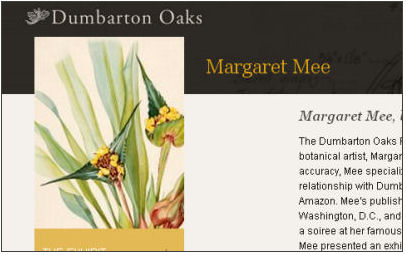 This
web exhibit is the first of its kind from any of the holders of large collections
of Margaret Mee's work. The Dumbarton Oaks collection has a history dating back
to April 18th 1967 when Margaret gave a talk to the Trustees of Harvard University
and their guests in the Garden Library of Dumbarton Oaks in what was then the
home of Mildred Woods Bliss. This
web exhibit is the first of its kind from any of the holders of large collections
of Margaret Mee's work. The Dumbarton Oaks collection has a history dating back
to April 18th 1967 when Margaret gave a talk to the Trustees of Harvard University
and their guests in the Garden Library of Dumbarton Oaks in what was then the
home of Mildred Woods Bliss.
Mrs
Woods Bliss purchased three of Margaret's paintings. Others were soon acquired
and the Collection now consist of 21 full-size paintings of Brasilian flora including
some from Amazonia. The paintings are valuable as they come from the most important
phase of Margaret's career when she was developing her technique and finding her
fascination with Amazonia. Nonesuch Expeditions helped by providing some photographs
and detail of Margaret's life The
site has more information and the paintings - SEARCH FOR DUMBARTON OAKS MARGARET
MEE. |
| |
March
1st 2013 — Our
Cloud Collections 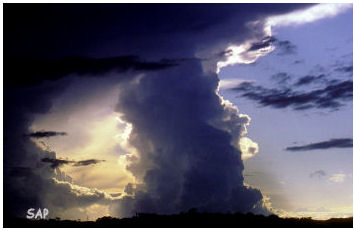 Since
March have been using The Cloud for storing our collections - pictures-videos-
audio recordings - memorabilia- research notes and more. Since
March have been using The Cloud for storing our collections - pictures-videos-
audio recordings - memorabilia- research notes and more. The
first Cloud Collections are The Steamship Great Britain, Margaret Mee,
the Falkland Islands / Islas Malvinas - a snapshot of life in 1969, Chipaya [Bolivia]
1963, and the Danube 1966. The Danube photographs will feature on this site later
this year. One major collection spanning fifty years will be 'the environment'
across South America When
completed we will open to researchers sets of 'thumbnail' files from the Collections
of Nonesuch Expeditions and South American Pictures. |
| |
November
21st 2012 - London, — The
InterOceanic Highway: The missing link in the exploitation of Amazonia?
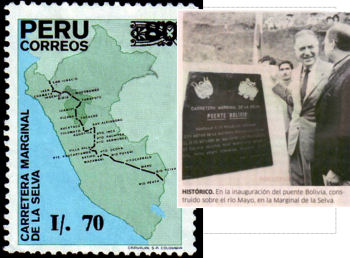 Tony
Morrison and John Forrest, Chairman of TReeS - The Tambopata Reserve Society presented
the Anglo Peruvian Society with an update on the current and possible future environmental
impact of the Interoceanic Highway. The prospect of a highway passing through
the species-rich area of Madre de Dios has concerned environmentalists for many
years.The region has oil deposits , plentiful alluvial gold, timber and land available
to settlers. The road was opened in 2012 road is seen by many as a disaster for
the forest. Tony
Morrison and John Forrest, Chairman of TReeS - The Tambopata Reserve Society presented
the Anglo Peruvian Society with an update on the current and possible future environmental
impact of the Interoceanic Highway. The prospect of a highway passing through
the species-rich area of Madre de Dios has concerned environmentalists for many
years.The region has oil deposits , plentiful alluvial gold, timber and land available
to settlers. The road was opened in 2012 road is seen by many as a disaster for
the forest.
John
commenced the evening with an account of highway planning in the 1960's and 70's
in the time of the Peruvian President, Fernando Belaunde, a visionary architect.
Belaunde pushed forward a major plan for a road along the eastern fringes of the
Andes Mountains and also had plans for a new capital city - Constitución
to be built in the Amazon forest. A preçis of the talk READ
AS PDF |
| |
October
2012— Achieving a Dream Along the TransAmazonica -BR230 [Dateline Altamira,
Para State, Brasil] 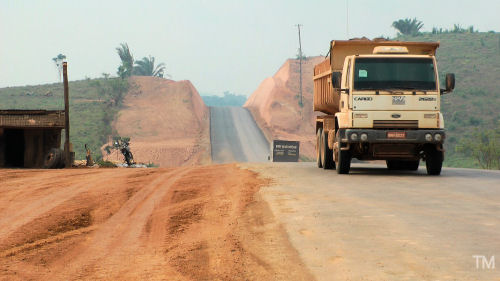 Back
in 1970 Tony Morrison was in Brasil for the BBC to cover a story about the great
thrust into Amazonia - at the time the TransAmazon highway was a mere twinkle
in the eye of the Generals running the country. Back
in 1970 Tony Morrison was in Brasil for the BBC to cover a story about the great
thrust into Amazonia - at the time the TransAmazon highway was a mere twinkle
in the eye of the Generals running the country.
The
highway was started in 1972 but for personal reasons Tony was unable to make the
film. Now forty years later and after many other films he has made in Amazonia,
Tony and his wife Marion have just travelled 880 kms along the TransAmazonica
-TransAmazon Highway - the BR230 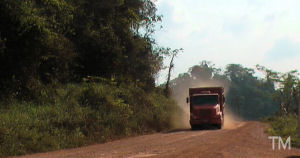 Some
of their journey was rough and dusty but they found one sector being seriously
upgraded. Some
of their journey was rough and dusty but they found one sector being seriously
upgraded.
The
work is along a 300km stretch where heavy traffic is expected for the construction
of the controversial Belo Monte dam on the Xingú river. The dam is being
built at an estimated cost of 18.5 billion US dollars and will have three components
of which Belo Monte at 3,545m long and 90m high is the largest. The
story will be in The New Amazonia section on this site. |
| |
September
27th / October 11th 2012 —The
Festival of Rio-2012
The Rio de Janeiro International Film Festival 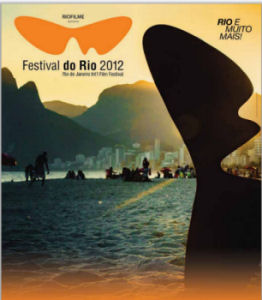 The
story of Margaret Mee and the Moonflower is told for the first time for
television in a Brasilian documentary selected for screening in the Festival of
Rio. The title Margaret Mee e a Flor da Lua has been made in HD for large
screen and cinema viewing. The producer is Elisa Tolomelli with her company EH!
Filmes, Rio de Janeiro and the director is Malu de Martino. The
story of Margaret Mee and the Moonflower is told for the first time for
television in a Brasilian documentary selected for screening in the Festival of
Rio. The title Margaret Mee e a Flor da Lua has been made in HD for large
screen and cinema viewing. The producer is Elisa Tolomelli with her company EH!
Filmes, Rio de Janeiro and the director is Malu de Martino.
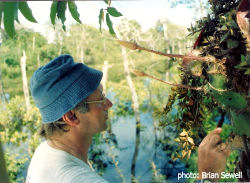 Many
people who knew Margaret have been interviewed for the production. The documentary
was made in Amazon locations and places in England including the Royal Botanic
Gardens, London. Historic video shot by Brian Sewell in 1988 on Margaret's fifteenth
Amazon journey and produced by Tony Morrison has been incorporated in the film.
The documentary also includes a large collection of archive images assembled by
the Brasilian producers. Many
people who knew Margaret have been interviewed for the production. The documentary
was made in Amazon locations and places in England including the Royal Botanic
Gardens, London. Historic video shot by Brian Sewell in 1988 on Margaret's fifteenth
Amazon journey and produced by Tony Morrison has been incorporated in the film.
The documentary also includes a large collection of archive images assembled by
the Brasilian producers.
Left
- 1988 Rio Negro, Brasil - Tony examining a 'Moonflower bud' during the filming
of Margaret Mee's last journey. |
| |
Tony
Morrison [far right] with Gilberto Castro and Malu de Martino said at a Press
Conference in Rio
It was back in 1970 when I was making documentaries
for the BBC in South America that I first heard about Margaret Mee . The headline
story of the year was the ambitious plan for the TransAmazon Highway [BR 230]
to which Margaret was vehemently opposed.. As I unravelled Margaret's extraordinary
story I was amazed by her multifaceted character - she was a determined traveller
- a remarkably skilful artist - a quiet temptress ...... and above all, a great
storyteller. The
account of Margaret's final journey, her life and work is in Margaret Mee's
Amazon on this site | |
| |
June
5 / 6th 2012 —
The
transit of Venus 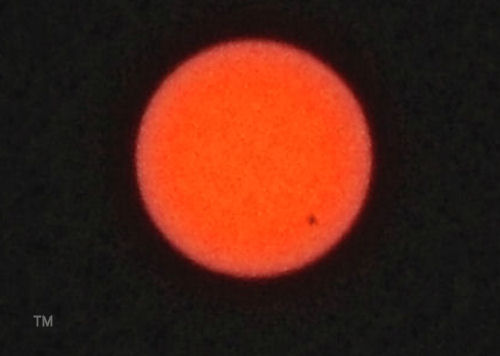 Venus
transits occur four times in approximately 243 years; and they appear in pairs
of events separated by about eight years. These pairs are separated by about 105
or 121 years. Venus
transits occur four times in approximately 243 years; and they appear in pairs
of events separated by about eight years. These pairs are separated by about 105
or 121 years.
The
transit has has occurred only seven times in the years since the invention of
telescopes. in 1631, 1639, 1761, 1769, 1874, 1882 and 2004. The next pair of events
will be in 2117 and 2125- with life expectancy increasing many children born on
this day will be seeing or hearing news of those transits. For people it Britain
it will be remembered by its coincidence with the Diamond Jubilee of Queen Elizabeth
ll This picture
was taken in southeast England during the 2004 transit. The image was made on
an inexpensive digital camera - A Fuji Finepix 7000 using silvered polyester sheeting
to critically reduce the exposure to sunlight and protect the camera's sensor.
The camera was handheld. Unfortunately cloud obscured the sunrise 'window' for
seeing the event from the same place this year - 2012. Tony Morrison |
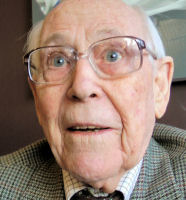 March
28th 2012 Trevor
Stephenson and his wife Helena settled back in their apartment / flat in Lima,
Peru Trevor and Helena who married in Lima on the 16th January 1947 and who for
many years made their life and home in South America had been in London England
since the 1990s. Trevor's story starting in the 1930's is in Nonesuch Extra -
Reminiscences of 60 years in South America Trevor was 97 this year. March
28th 2012 Trevor
Stephenson and his wife Helena settled back in their apartment / flat in Lima,
Peru Trevor and Helena who married in Lima on the 16th January 1947 and who for
many years made their life and home in South America had been in London England
since the 1990s. Trevor's story starting in the 1930's is in Nonesuch Extra -
Reminiscences of 60 years in South America Trevor was 97 this year.
March
14th 2012 —An Award for the Yavari The 150 year old Yavari, originally
a steamship on Lake Titicaca, Peru and the oldest of a small fleet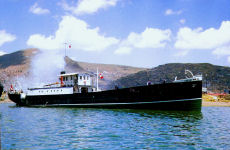 was
given a Heritage Enginering Award in London. Tony Morrison a co-founder of Nonesuch
Expeditions and the longest serving trustee of the Yavari Project responsible
for the preservation and restoration of the ship was one of the guests at a luncheon
at the Institution of Mechanical Engineers, in London, England. was
given a Heritage Enginering Award in London. Tony Morrison a co-founder of Nonesuch
Expeditions and the longest serving trustee of the Yavari Project responsible
for the preservation and restoration of the ship was one of the guests at a luncheon
at the Institution of Mechanical Engineers, in London, England. WATCH
THE VIDEO |
| |
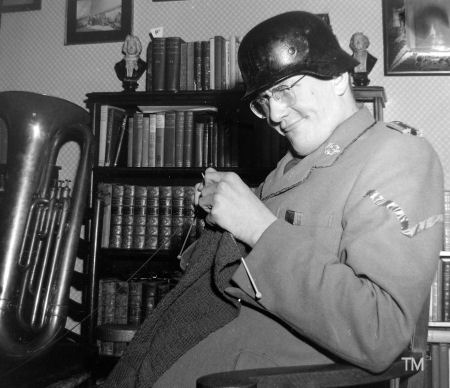 March
8th 2012 March
8th 2012
Bob
Giddings - [Emeritus Professor Robert Giddings].Polio victim and one of the
great humorists of the University of Bristol Union in the late 1950s' has died.
Bob will be remembered by his friends of the Revue society Revunions and
from all enthusiasts of the annual Rag Show as he created a band to play German
martial music - the Auerbol-Saaricschen Lederhosenmusik. Bob
conducted from his wheelchair ' More more' [Ed]. ' It was Bob all over to have
a plastic 8 pence ticket from the cake stall in the Union Refectory stuck in his
History of England on the top shelf of his bookcase' says Tony Morrison
who took dozens of pictures of the band. Bob
contracted polio when he was eleven and after a slow start with schooling he arrived.
Bob read English and German at Bristol and received a PhD from Keele. He taught
in a couple of schools before joining the staff at Bath Technical College. His
next move was to Bournemouth University where he eventaully became the Professor
Emeritus in the School of Media, Arts and Communication. No wonder he claimed
his band 'incorporated the entire 5th Afrika Korps 1944-1944'. He could inspire
and raise a very good laugh. Bob
wrote twenty books, contributed to BBC televison shows, and wrote for magazines
including the Listener [BBC] . New Society and the New Statesman. |
| |
January
3rd 2012 The paper edition of Saving the Great Britain was published
by Nonesuch Expeditions 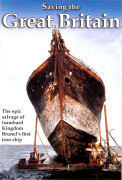
October
1st 2011 - The InterOceanic Highway Tony and Marion Morrison set out
from Puerto Maldonado, Peru, to follow the road eastward to São Paulo,
Brasil WATCH
THE VIDEO September
26th 2011 - Machu Picchu Remembered Marion Morrisontalks with Nick
Asheshov in Urubamba, a town in the Sacred Valley of the Incas, Peru WATCH
THE VIDEO |
| |
July
2011 Michael (Mike) Gore died in Madrid. Mike
Gore was one of the team making films in the Middle East for BBC TV. Tony Morrison
recalls that 'Mike was immensely sharp and streetwise. He taught me so much
about film reportage and how to handle tricky situations. Read more about
those trips in the Features pages of this site. The picture was taken in Beirut,
Lebanon 1962 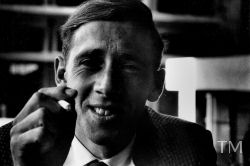 After
the Middle East in 1962 Michael Gore moved to Spain and set-up his own reporting
service for television news. It was not the all-in one-video of today but meant
using a heavy camera, rolls of 16mm film and a separate sound recorder. After
the Middle East in 1962 Michael Gore moved to Spain and set-up his own reporting
service for television news. It was not the all-in one-video of today but meant
using a heavy camera, rolls of 16mm film and a separate sound recorder.
One of Mike's great achievements was his near daily coverage of the 1966 Palomares
Hydrogen Bomb Incident at Palomares near Almeria in southern Spain.
A US AirForce B52 bomber carrying H bombs collided with a tanker while refuelling
at 31,000 feet. The detonators of some bombs exploded on impact with the ground
so plutonium was scattered around. One
bomb went missing in the sea. Mike would shoot film in the morning and then drive
to Madrid where it was processed and sent to London - and then he would drive
back to Plaomares overnight to report again the next day.... and so on and on
- the roads were not today's express routes. |
| |
July
24th 2011 Machu Picchu - Lost City of the Incas 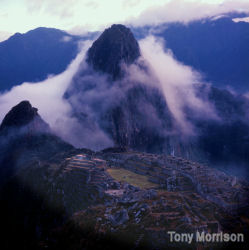 As one of the world's 'must do before I die ' tourist destinations and a World
Heritage site Machu Picchu in Peru is in the news again...... One hundred years
ago the American academic Hiram Bingham first set his eyes on the ruin - a year
later he gave the first account in Harper's Magazine, New York. Then in
1913 the National Geographic Magazine devoted an entire issue to Bingham's
work and in 1922 he wrote a book Inca Land and another followed in 1930.
The lighter, easier reading Lost City of the Incas was first published
in 1948. The NGS Magazine of 1913 has been republished by the Society.
As one of the world's 'must do before I die ' tourist destinations and a World
Heritage site Machu Picchu in Peru is in the news again...... One hundred years
ago the American academic Hiram Bingham first set his eyes on the ruin - a year
later he gave the first account in Harper's Magazine, New York. Then in
1913 the National Geographic Magazine devoted an entire issue to Bingham's
work and in 1922 he wrote a book Inca Land and another followed in 1930.
The lighter, easier reading Lost City of the Incas was first published
in 1948. The NGS Magazine of 1913 has been republished by the Society.
Films, television and now the popularity of the 'Inca Trail', a path through spectacular
mountain scenery guarantees over 2000 visitors a day. Machu Pichu is often so
crowded that UNESCO and the local guardian body the INC [Intstuto Nacional de
Cultura - National Cultural Institute] are anxious that the wave of human traffic
will damage the ancient stones. They close the gates at 2,500 visitors per
day. When
the members of the University of Bristol Trans-Continental Expedition team arrived
at the ruins by steam train in June 1961 they found just a handful of visitors.
Wealthy tourists stayed in the small almost rustic state-run hotel and others
like the Expedition team simply camped in the ruins. Entry was informal and paid
at the hotel. How
lucky .. We
spent spent two days at Machu Picchu and by camping we saw the dawn in near solitude.
The only sounds came drifting upwards from birdlife and insects in the tropical
valley 2000 feet [610m] below. By a stretch of an ear we heard the sound of the
Urubamba river tumbling over rocks. Two more years passed and I was back with
Mark Howell making a professional film for BBC TV and then a year later searching
for another lost city; also for BBC TV. Altogether
I made five television films with sequences at Machu Picchu, largely because the
excutive producers always said " be sure to get that old city in the mountains
... Machoo something or other, I can't remember the name." I was not the
only producer of Machu Picchuana and by the 1980's it was common to see units
from several countries all trying to keep ' out of shot' of another camera. |
| |
Fifty
years on Now
any Machu Picchu story makes world news and the argument of who discovered the
site rolls on and on. What is certain is that Bingham was not the first to get
to the ruins. In his book Inca Land on page 324 he says he saw the name
'Lizarraga 1902' scrawled on one of the walls. He overlooked this little matter
when writing Lost city of the Incas now in its zillionth paperback. Agustín
Lizarraga lived in the Urubamba valley below Machu Picchu and though he left his
mark was almost certainly not the first to get there. Watch this site for some
ideas - Tony Morrison |
| READ
The original book Inca Land 1922 by Hiram Bingham in which he describes
how he was led to the site [page 314]. This book is in the Internet Archive |
| | READ
Malcolm McKernan - Looking down on the 'Lost City of the Incas'
for the Western Daily Press, Bristol - August 1961 |
|
| READ
Hiram Bingham's account of the discovery in National Geographic Magazine | National
Geographic Magazine 1913 | | WATCH
The classic TV footage filmed in June 1961 by Tony Morrison |
|
| |
| |
February
2011, Cheddar Man A
BBC TV series A History of Ancient Britain led to the resurgence
of interest in a skeleton found 1903 in Gough's Cave Cheddar, Somerset England.
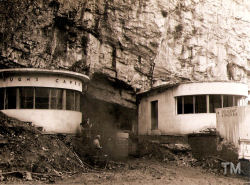 Gough's
Cave is in a limestone rock formation in the Mendip Hills approx 13 miles (23
kms ) south of Bristol. The find was made by Arthur and William Gough's
Cave is in a limestone rock formation in the Mendip Hills approx 13 miles (23
kms ) south of Bristol. The find was made by Arthur and William 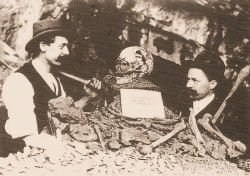 Gough
and following extensive research has since been recognised as the oldest complete
human skeleton known in Britain. It dates from 7,150 BC and is kept at the Natural
History Museum in London where it is not on public display. Gough
and following extensive research has since been recognised as the oldest complete
human skeleton known in Britain. It dates from 7,150 BC and is kept at the Natural
History Museum in London where it is not on public display.
The
skull was seen on the television programme and other research also seen on television
in the 1990s employed mitochrondial DNA testing. Links were discovered between
some residents in the local Cheddar village - details are available on the web. One
of the best accounts of the discovery and early work is in the Proceedings, University
of Bristol Spelæological Society. The UBSS is often known as the Caving
Society despite its long tradition of academic study History
and Literature of Pleistocene Discoveries at Gough's Cave, Cheddar, Somerset
by R.M Jacobi, Proceedings 1985 [PDF
4.5 MB read and download] The
skeleton displayed in the Gough's cave museum today is a replica. But back in
1957 before the original was moved Tony Morrison was asked to take a series of
photographs of which four were sent to the British Museum. At the time two eminent
men from the UBSS were studying the remains:  Dr.Oliver
Cromwell Lloyd [right] a pathologist and senior lecturer usually known as 'Oliver'
and Dr.Oliver
Cromwell Lloyd [right] a pathologist and senior lecturer usually known as 'Oliver'
and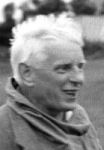 Professor
E.K Tratman [left] usually known as 'Tratty', a retired professor of dentistry
and at the time the UBSS Society's President. The two specialists had medical
as well as archaeological interest in the skeleton. Professor
E.K Tratman [left] usually known as 'Tratty', a retired professor of dentistry
and at the time the UBSS Society's President. The two specialists had medical
as well as archaeological interest in the skeleton.
Prof.Tratman wrote several papers including Problems of The "Cheddar Man",
Gough's Cave, Somerset. Proceedings, [PDF
read and download 4.5
MB ] The paper comments on the discovery and early research. Here
for the first time Nonesuch News publishes the original photos of the original
skeleton. When found in pieces it was complete apart from parts of the hands -
those seen in the photo below are replicas |
| |
July
19th 2010 SS
GREAT BRITAIN, Bristol, England. 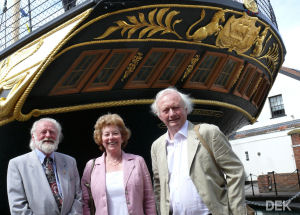 The
Fortieth Anniversary Celebrations for the return of the Great Britain.
It was forty years ago to the
day that Isambard Kingdom Brunel's iron ship Great Britain was returned
to the dock where she was launched in 1843. The historic launch is more correctly
described as a 'floating' because the dock was empty of water for the building
and was then filled for the launch. The story of the Great Britain is on
this site. Originally designed as a steamship the SS Great Britain has
been restored magnificently. A celebration 'tea party' held in the grand First
Class Saloon was attended by many of the people involved with the salvage in 1970 The
Fortieth Anniversary Celebrations for the return of the Great Britain.
It was forty years ago to the
day that Isambard Kingdom Brunel's iron ship Great Britain was returned
to the dock where she was launched in 1843. The historic launch is more correctly
described as a 'floating' because the dock was empty of water for the building
and was then filled for the launch. The story of the Great Britain is on
this site. Originally designed as a steamship the SS Great Britain has
been restored magnificently. A celebration 'tea party' held in the grand First
Class Saloon was attended by many of the people involved with the salvage in 1970
Ray Sutcliffe,
Marion and Tony Morrison meet again below the decorated stern of the restored
SS Great Britain / Photo David Elkington Cole.
In 1970 Ray was a producer for the BBC Archaeology and History unit and Tony and
Marion were film-makers and writers then based in South America. Marion reported
the salvage for the Observer, London. David a long time friend and colleague who
took the photo is no newcomer to Bristol and its special occasions. |
| |
| Ray
Sutcliffe's classic documentary The
Great Iron Ship for the Chronicle series can be seen on BBC Archive iPlayer
- a web service unfortunately at present viewable only in the United Kingdom.
The film includes a short history of the ship and unique footage of the salvage
filmed by Tony and Marion. [50 minutes.] |
|
| For
historic 8mm colour footage of the departure from the Falkland Islands and some
actuality audio see this site for Saving
The Great Britain | |
| To
read Marion's account for the Observer Magazine 21st June 1970 | | | |
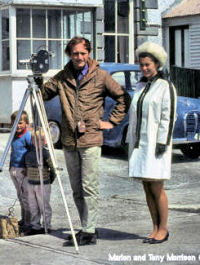
| 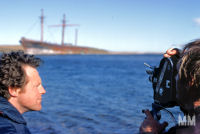 |
Ray - left and
Tony filming in Sparrow Cove , Falkland Islands in 1970 Tony
and Marion in Stanley, Falkland Islands 1969 For
the fashion conscious - Marion took her Mary Quant, King's Road, London raincoat
to Stanley. She says ' In the 1960's few people had little or no idea of what
clothing was suitable for life in the island's tiny capital.' |
| |
| |
March
1st 2010 Margaret Mee The first of a series of short video clips of
Margaret Mee was launched on this site - see the menu-left November
11th 2009 Margaret Mee, Rio de Janeiro. Brasil. An exhibition marking
the Margaret Mee's One Hundred Years opened at the Centro Cultural dos Correios
de Rio de Janeiro, a modern exhibition space set in the old Post Office building
built in 1922. The date of the exhibition does not quite match the day when she
would have been 100 - that was on May 22nd but the show arranged by Sylvia de
Botton Brautigam contains a stunning display of paintings, photographs, personal
memorabilia and video. Sylvia was one of the original team that established the
now defunct Fundação Botânica Margaret Mee in
1988. [see left: Margaret Mee Amazon Trust Part 2] But it is wonderful
to see how Margaret's ideals and inspiration are being remembered. Also it is
worth recalling how examples of Margaret Mee's work appeared in a set of Brasilian
postage stamps in 1992.  The
stamps were issued at the time of an another exhibition in the same building and
focused on the environment. The timing was chosen to coincide with the major United
Nations Conference on the Environment and Development [UNCED] known as informally
as the Earth Summit or Rio 92 and this is inscribed on the left side of each stamp.
At the bottom of each is written Homage to Margaret Mee. The flowers depicted
are - left to right - Canistrum cyathiforme, Nidularium rubens, Canistrum
exiguum, and Nidularium innocentii The
stamps were issued at the time of an another exhibition in the same building and
focused on the environment. The timing was chosen to coincide with the major United
Nations Conference on the Environment and Development [UNCED] known as informally
as the Earth Summit or Rio 92 and this is inscribed on the left side of each stamp.
At the bottom of each is written Homage to Margaret Mee. The flowers depicted
are - left to right - Canistrum cyathiforme, Nidularium rubens, Canistrum
exiguum, and Nidularium innocentii
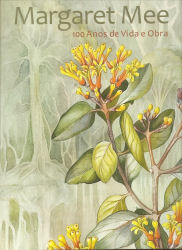 The
cover for the exhibition catalogue uses a painting dated May 1988 from the Rio
Negro the year she was taken there by Nonesuch Expeditions/ South American Pictures.
The 1988 journey also known as her Fifteenth to Amazonia was dedicated to a search
for the Moonflower cactus [Selenicereus wittii] Details are on the
Menu / index - left The
cover for the exhibition catalogue uses a painting dated May 1988 from the Rio
Negro the year she was taken there by Nonesuch Expeditions/ South American Pictures.
The 1988 journey also known as her Fifteenth to Amazonia was dedicated to a search
for the Moonflower cactus [Selenicereus wittii] Details are on the
Menu / index - left
The
flower is a Loranthaceae, a parasitic plant of the igapos / flooded
forest the painting is from a private collection. |
| |
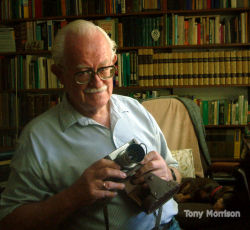 November
3rd 2009 Dr.
Franz Ressel , known to friends as 'Pancho' died aged 80 in Santa Cruz,
Bolivia. Franz Ressel was an enthusiastic supporter of Nonesuch Expeditions with
a close friendship dating back almost fifty years. In 1961 he met the Bristol
University Trans-Continental Expedition team when they were in Bolivia. An account
of Franz' help and encouragement given liberally in so many ways will be published
on this site. November
3rd 2009 Dr.
Franz Ressel , known to friends as 'Pancho' died aged 80 in Santa Cruz,
Bolivia. Franz Ressel was an enthusiastic supporter of Nonesuch Expeditions with
a close friendship dating back almost fifty years. In 1961 he met the Bristol
University Trans-Continental Expedition team when they were in Bolivia. An account
of Franz' help and encouragement given liberally in so many ways will be published
on this site.
|
| |
July
19th 2009 The
Incredible Journey Is an Oral History Project from the SS Great Britain
team in Bristol. Tony and Marion Morrison who were on the spot filming in the
Falkland Islands / Islas Malvinas are contributing memories from the time in 1969,
when the bowsprit was raised from the bed of Sparrow Cove. And then again from
the following year 1970 when they covered the actual salvage.. They will be adding
photographs and sound recordings from their collection. The project will be completed
in 2010 , forty years after the SS Great Britain was saved and towed back to Bristol April
2009 After a break of three years Nonesuch News returns on a new site ready
to contribute to three special anniversary years. This Nonesuch Expeditions site
takes over all the pages from Nonesuchinfo and Margaret Mee's Amazon and will
contain more information. It will continue the story of Brunel's SS Great Britain
now restored in Bristol and will cover our special contribution to the 'Salvage'
project being prepared for 2010 - forty years on from the actual salvage in the
Falkland Islands / Islas Malvinas. Other pages will be devoted to the University
of Bristol Trans-Continental Expedition almost fifty years since its departure
for India and South America in 1960. And the News will be remembering that 2009
is the Centenary Year of the University. |
|
| |
April
2006 The 200th Anniversary of the Birth
of Isambard Kingdom Brunel the visionary and brilliant engineer who conceived
the idea of the Steamship Great Britain and much more.
As a contribution to the celebration of the life of Brunel Nonesuchinfo
is launching three Features about the Steamship Great Britain, designed by Brunel,
and launched in Bristol, England in 1843. It is with thanks to the foresight of
marine engineering consultant Dr. Ewan Corlett and an extraordinary salvage operation
in 1970 that the Steamship Great Britain was saved . It is now one of the most
fascinating museums in the United Kingdom ISAMBARD
KINGDOM BRUNEL AND THE STEAMSHIP GREAT BRITAIN |
| |
August
2005 Reverend Dr. Ewan Corlett It
is with immense sadness that Nonesuch News learnt of the death of Ewan Corlett
on Monday August 8th 2005. The Reverend Dr. Ewan Corlett as he became known in
his retirement was responsible for the first steps towards saving the Victorian
Steamship Great Britain. |
| |
Montevideo
, Uruguay , May 1970.
Ewan Corlett was at the dockside to inspect the hulk on its way from the Falkland
Islands/ Islas Malvinas to Bristol [England]. | |
| |
July
2005 Re-launch of the SS Great Britain , Bristol, England
Isambard Kingdom Brunel, the Steamship Great Britain and the City of Bristol in
England are names that will be linked forever. On July 19th 2005 the SS Great
Britain was formally 're-launched' after major restoration lasting over thirty
years. The 'Britain' as the ship is known affectionately was built in this dock
in Bristol and launched from it on July 19th 1843. After an eventful life as an
active vessel, the 'Britain' arrived in the Falkland Islands / Islas Malvinas
in 1886 disabled by a storm and shifting cargo. After being declared a wreck the
'Britain' remained in the Islands until a salvage operation was mounted in 1970.
The ship was towed on a pontoon to Avonmouth the port for Bristol early in 1970
and returned to the original dock also on July 19th of the same year . More of
this story will be told in a Nonesuch Expeditions feature | |
| |
With
great care .... The
restoration has been made with great care for detail that gives some idea of the
grand design created by Brunel in the early years of Victorian enterprise.
Here the restored stern with
gallery windows is under the gilded Coat of Arms [armas / escudo] of the
City of Bristol. The emblem dating from the 16th century links a flourishing maritime
tradition with the strength of the city. The central image is flanked by two unicorns
and depicts a sailing ship leaving the safety of Bristol castle. Unicorns
are legendary beasts with the body of a horse bearing a single, long, straight
horn. They were reputed to have medicinal properties | |
| |
| The
SS Great Britain is open to to the Public and a dockside museum tells the story
of the ship |
| |
June
2005 A Bristol Road in India Pusegaon,
Maharashtra State, INDIA A
new road in the small town of Pusegaon has been named "THE BRISTOL ROAD"
to commemorate the historic reunion in late 2000 of three members of the team
of six graduates from the Bristol University Trans-Continental Expedition [1960-1961] England
and friends they made in Pusegaon in 1960. Back in Bristol the University Vice
Chancellor was Chairman of the Finance Committee and The Rt. Hon The Lord Mayor
of Bristol was the expedition Patron so support from the City was exceptional.
| '
you wouldn't recognise the old road today' | Apart
from studies in India and later in Bolivia the team had a mission to carriy the
Bristol name to many countries around the world . The recently named Bristol Road
in Puseagon is close to the traditional 'Government Bungalow' where the team lived
for two months late in 1960. As Balasahib Jadhav a member of the Reunion 2000
Steering Committee in India said when he sent the picture ' you wouldn't recognise
the old road today'. | |
| |
October
1960 Pusegaon, Maharashtra, India Here
some of the team are in the garden of the Government Bungalow with
three students from the High School. The students were fascinated by one of the
two Expedition vehicles, an Austin Gipsy provided by an agent in Bristol. Malcolm
McKernan is typing notes [seated left], Peter Krinks is explaining the
route from Bristol to India and Mark Howell [right] is recording the conversation
for a TV film backed by TWW [Television Wales and West] the regional Independent
Televison producer at the time. The Puseagon Pages have the story of the
Reunion 2000 and copies of the reports Malcolm McKernan sent to the Western Daily
Press in Bristol [England] The
team left Pusegaon late in December 1960 and drove south before crossing to Sri
Lanka [then also known as Ceylon] and continuing by sea to Singapore | |
| |
| Footnote
Mark Howell was
one of the two founder members of the Trans-Continental Expedition and one of
the two Bristolians on the epic journey. The team's doctor, Don Pilton was the
other. Later, Mark was one of the two founders of Nonesuch Expeditions [see
ABOUT NONESUCH]. He was unable to join the reunion trip through
ill-health and after a short illness died in December 2002. Other than the University
Expedition, his business trips to Australia and Japan, and extensive travels in
South America with Nonesuch Expeditions Mark had lived all his life in Bristol. |
| |
|
|
| The
text and most of the images are © Copyright |
| For
any commercial use please contact | | |
| THE
NONESUCH - FLOWER OF BRISTOL |
| AN
EMBLEM FOR ENTERPRISE | | |